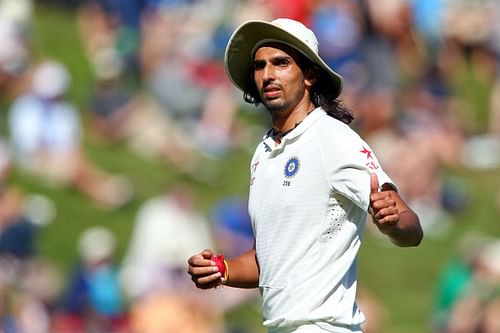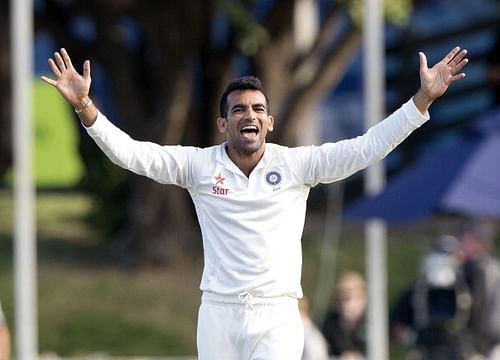
Blowing hot and cold: Assessing India's top bowling options
India were staring down the barrel in the 2nd Test against the Kiwis and it felt like a peculiarly familiar position.
In December 2013, India had found themselves in a position of supremacy against South Africa which had quietly surprised Indian supporters as the Proteas had their backs against the wall chasing an unprecedented target of 458.
The lack of any real teeth in India’s bowling, combined with a lack of imaginative captaincy, transformed the match from being an impressive performance overseas to one that left supporters pulling on their hair.
This group of players has given some shockingly underwhelming performances in Test match cricket. The only triumph in Test cricket in recent memory has been a hastily arranged home-series against the West Indies which, to be honest, was like bullying a harmless kid.
The defeats against South Africa and New Zealand differ from the ones suffered two years back against England and Australia. India’s batting line-up hasn’t bitterly disappointed even though they have been a tad inconsistent. Virat Kohli, Shikhar Dhawan, Cheteshwar Pujara, MS Dhoni and Ajinkya Rahane have stood up at different moments to build a challenge that should have translated into a solitary win if not a series triumph.
A measure of this is provided by the fact that India registered a single score of over 300 in 4 Test matches against Australia in 2011-12, a single score of 300 again against England just before that in 2011 whereas India has registered 4 convincing scores of over 300 in just 4 Test matches against South Africa and New Zealand.
The area of concern, which has been a running string in every single fixture from Johannesburg to Wellington, is India’s inability to take 20 wickets. We cannot really blame India’s spin department for this debacle given that they have been bowling in conditions that favour the faster bowlers. Moreover, Ravindra Jadeja has stood up for India in unlikely situations even if we hold Ashwin accountable for a few under-par performances.
Now, we have have narrowed down to the real core of the problem: India’s pace bowling. It did not really require so much rocket science as anyone who has religiously followed the Tests patiently overcoming time barriers in India.
The bowling department hasn’t fired in unison. There are no signs of planned dismissals and coordinated efforts to break up a partnership. The trend has been that batsmen have been able to stand ground when they have wanted to, whether it be Faf du Plessis and ABD, or McCullum and Watling.
The Indian bowling attack is becoming a specialist in creating heroes for the opposition side. This article will assess the performance of India’s bowling options, taking into account recent efforts across all formats in order to come to some kind of a conclusion that may benefit India going ahead.
Ishant Sharma : Rating: 5.5/10

Ishant Sharma
The lanky pacer redeemed himself a little with a couple of potentially match-winning spells in New Zealand but he epitomizes the inconsistency of India’s bowling efforts. Ishant is a bowler of limited capabilities who sticks to his natural length and doesn’t swing the ball.
He relies on his decent pace, nip off the pitch and menacing bounce to trump his opponents. He has savoured some success with this approach and the constant point of reference when it comes to establishing his talent is the spell he bowled against Ricky Ponting at Perth on the tour of Australia in 2007/08.
However, that was seven years ago and Ishant has gained enough experience at the international level for people to judge him on his performances and not on his talent. He is no more ‘a player of potential’, but a player who is under-performing and lacks teeth to match the likes of Dale Steyn and James Anderson.
This kind of criticism may seem harsh with the fresh memory of his exploits in New Zealand but such performances have been few and far between. Moreover, the incriminating evidence against his name is his performances in the shorter format of the game.
Ishant Sharma has shown extreme reluctance to change his approach during death overs making him a liability on the team and he was rightly evicted from the T20 World Cup squad as well as the squad for the upcoming Asia Cup.
He had a terrible home series against Australia when he was scored of at over 7.0 runs per over and didn’t finish his full quota of 10 overs in the three matches that he played. He was taken full toll of once again in South Africa and New Zealand proving the weakest of the lot in the limited overs format.
So what does the future hold for Ishant Sharma? I consider it a wise call to give him some time off from the limited overs format and give fresh audience to some other options in order to devise a larger framework for the 2015 World Cup. Ishant Sharma can add more teeth to his bowling in the meantime.
He has his share of assets. He bowls tirelessly, long spells that are required especially in the sub-continent and can take advantage of tracks that offer a bit of pace and bounce. It wouldn’t be the worst idea to reserve him for the Test format which seems to suit his style of play much better.
Zaheer Khan: Rating: 5/10

Zaheer Khan
India’s veteran campaigner has given his best years to the national side and has been a loyal servant of the game. He worked his socks off in order to make a comeback to the national side. We must give him credit where credit is due.
However, it must be accounted that the pacer’s selection was also motivated by the fact that India was touring outside the sub-continent and required some leadership. In which case, he must be held accountable for the fact that in his stewardship India’s bowling attack failed to break critical deadlock situations when a few wickets would have allowed India to cross the line.
He was alarmingly average in terms of his wicket-taking figures, picking up 16 wickets in 4 Test matches (against NZ and South Africa) and still looked India’s best bowler at times.
Zaheer has a complete skill set and was a force to reckon with during his best years. He has adapted to new challenges in the course of time. He developed his reverse swing to capitalize upon the dryness of sub-continent surfaces and used the knuckle-ball to good effect when the limited overs format demanded it.
His weak-point has been his fitness, and he seems to become a little complacent from time to time. He is also on the wrong side of 30 which means that while we may still demand something of him, we cannot continue to rely upon him for long.
The best way to utilize Zaheer’s services would be to play him selectively. Give him a go against a top-opposition in the ODI format in order to assess his availability for the 2015 World Cup. We must prioritize nurturing of new talent and thus his participation in home tests can be argued given the availability of the likes of Md. Shami, Ishant Sharma, Umesh Yadav etc.